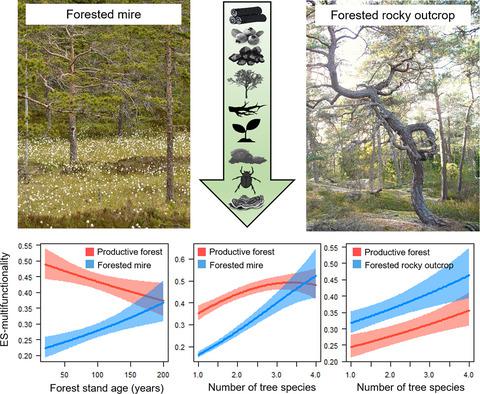当前位置:
X-MOL 学术
›
J. Appl. Ecol.
›
论文详情
Our official English website, www.x-mol.net, welcomes your
feedback! (Note: you will need to create a separate account there.)
Ecosystem service multifunctionality of low‐productivity forests and implications for conservation and management
Journal of Applied Ecology ( IF 5.0 ) Pub Date : 2020-04-01 , DOI: 10.1111/1365-2664.13569 Mari Jönsson 1 , Tord Snäll 1
Journal of Applied Ecology ( IF 5.0 ) Pub Date : 2020-04-01 , DOI: 10.1111/1365-2664.13569 Mari Jönsson 1 , Tord Snäll 1
Affiliation

|
Low-productivity forests are often the last remaining pristine forests in managed forest landscapes and typically overrepresented among protected forests. However, the provisioning of individual and multiple ecosystem services (ES-multifunctionality) by these forests remains poorly assessed, making it difficult to evaluate their importance in forest conservation and management.Here, using nationwide data on ES from over 2,000 forest plots, we test whether levels of ES-multifunctionality and individual ES differ between low-productivity forested mires and rocky outcrops in relation to the levels of productive forests, and as a function of forest age, tree species richness and climate. We defined ES-multifunctionality using different threshold values of the maximum levels (low, medium and high) and weighted these according to land-use objectives (equal weight of all services, greater weight to cultural and supporting ES or greater weight to production).We show that the ES-multifunctionality of forested mires is consistently lower than those of productive forests. However, the ES-multifunctionality increased with forest age in forested mires but not in productive forests. The ES-multifunctionality of forested rocky outcrops, on the other hand, was higher or equivalent to that of productive forests under equal weight and supporting land-use objectives, respectively. Our findings highlight that forested rocky outcrops can supply multiple ES, especially older forested stands with mixtures of coniferous and deciduous trees. Generally, we found no evidence for strong trade-offs between the ES studied and our results highlight the importance of forest age for increasing the ES-multifunctionality of low-productivity forests.Synthesis and applications. Low-productivity forests should not be exempt of forestry or protected purely based on low productivity or low land-use conflict if the goal is to conserve multiple ecosystem services (ES). Inclusion grounds for protecting low-productivity forests should instead carefully consider the site type (dry vs. wet), forest age and tree species richness. To maintain higher ES-multifunctionality in low-productivity forests, older or deciduous trees should also not be harvested. This will require changes in current conservation or management policies of low-productivity forests of some countries.
中文翻译:

低生产力森林的生态系统服务多功能性及其对保护和管理的影响
低生产力森林通常是管理森林景观中最后剩下的原始森林,通常在受保护森林中所占比例过高。然而,这些森林提供的个体和多种生态系统服务(ES 多功能性)的评估仍然很差,因此很难评估它们在森林保护和管理中的重要性。 在这里,我们使用来自 2,000 多个林地的 ES 的全国数据,进行测试ES 多功能性和个体 ES 的水平在低生产力森林沼泽和岩石露头之间是否因生产性森林的水平以及森林年龄、树种丰富度和气候而异。我们使用不同的最高水平阈值(低、中和高)并根据土地利用目标对这些进行加权(所有服务的权重相同,文化和支持 ES 的权重更大或生产的权重更大。我们表明,森林沼泽的 ES 多功能性始终低于多产的森林。然而,在森林沼泽中,ES 多功能性随着森林年龄的增加而增加,但在生产性森林中没有。另一方面,森林岩石露头的 ES 多功能性分别高于或等同于同等权重和支持土地利用目标的生产性森林。我们的研究结果强调,森林岩石露头可以提供多种 ES,尤其是具有针叶树和落叶树混合物的较老的森林林分。一般来说,我们没有发现所研究的 ES 之间存在强权衡的证据,我们的结果强调了森林年龄对于增加低生产力森林的 ES 多功能性的重要性。综合和应用。如果目标是保护多种生态系统服务 (ES),低生产力森林不应该被排除在林业之外或纯粹基于低生产力或低土地利用冲突而受到保护。保护低生产力森林的纳入地应仔细考虑场地类型(干与湿)、森林年龄和树种丰富度。为了在低生产力森林中保持较高的 ES 多功能性,也不应采伐老树或落叶树。这将需要改变一些国家目前对低生产力森林的保护或管理政策。
更新日期:2020-04-01
中文翻译:

低生产力森林的生态系统服务多功能性及其对保护和管理的影响
低生产力森林通常是管理森林景观中最后剩下的原始森林,通常在受保护森林中所占比例过高。然而,这些森林提供的个体和多种生态系统服务(ES 多功能性)的评估仍然很差,因此很难评估它们在森林保护和管理中的重要性。 在这里,我们使用来自 2,000 多个林地的 ES 的全国数据,进行测试ES 多功能性和个体 ES 的水平在低生产力森林沼泽和岩石露头之间是否因生产性森林的水平以及森林年龄、树种丰富度和气候而异。我们使用不同的最高水平阈值(低、中和高)并根据土地利用目标对这些进行加权(所有服务的权重相同,文化和支持 ES 的权重更大或生产的权重更大。我们表明,森林沼泽的 ES 多功能性始终低于多产的森林。然而,在森林沼泽中,ES 多功能性随着森林年龄的增加而增加,但在生产性森林中没有。另一方面,森林岩石露头的 ES 多功能性分别高于或等同于同等权重和支持土地利用目标的生产性森林。我们的研究结果强调,森林岩石露头可以提供多种 ES,尤其是具有针叶树和落叶树混合物的较老的森林林分。一般来说,我们没有发现所研究的 ES 之间存在强权衡的证据,我们的结果强调了森林年龄对于增加低生产力森林的 ES 多功能性的重要性。综合和应用。如果目标是保护多种生态系统服务 (ES),低生产力森林不应该被排除在林业之外或纯粹基于低生产力或低土地利用冲突而受到保护。保护低生产力森林的纳入地应仔细考虑场地类型(干与湿)、森林年龄和树种丰富度。为了在低生产力森林中保持较高的 ES 多功能性,也不应采伐老树或落叶树。这将需要改变一些国家目前对低生产力森林的保护或管理政策。











































 京公网安备 11010802027423号
京公网安备 11010802027423号